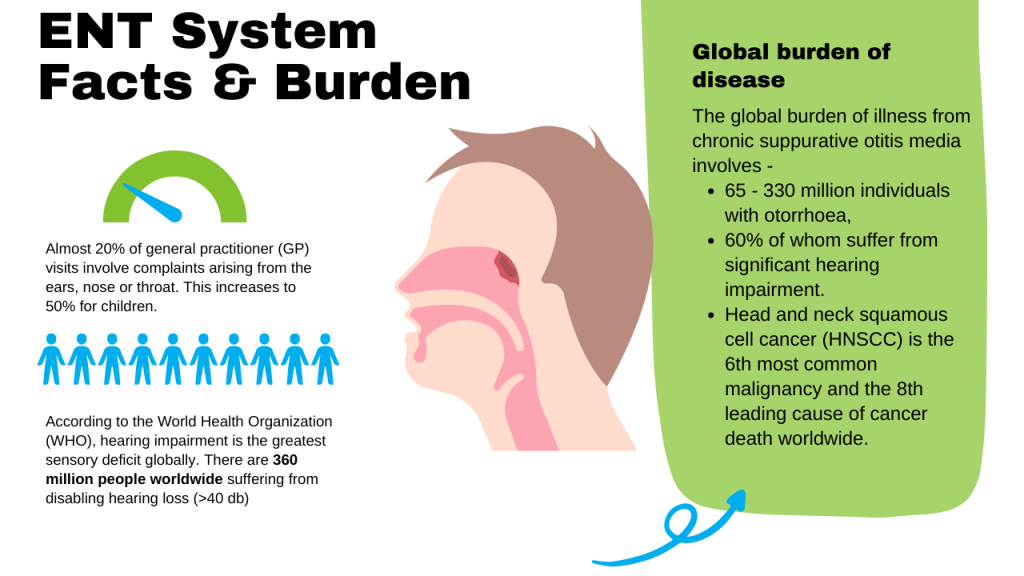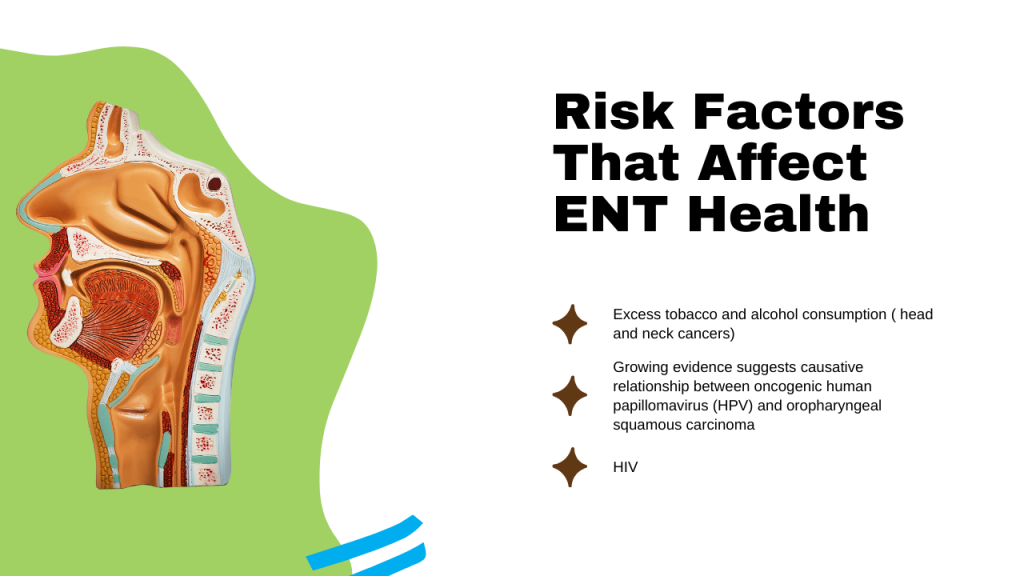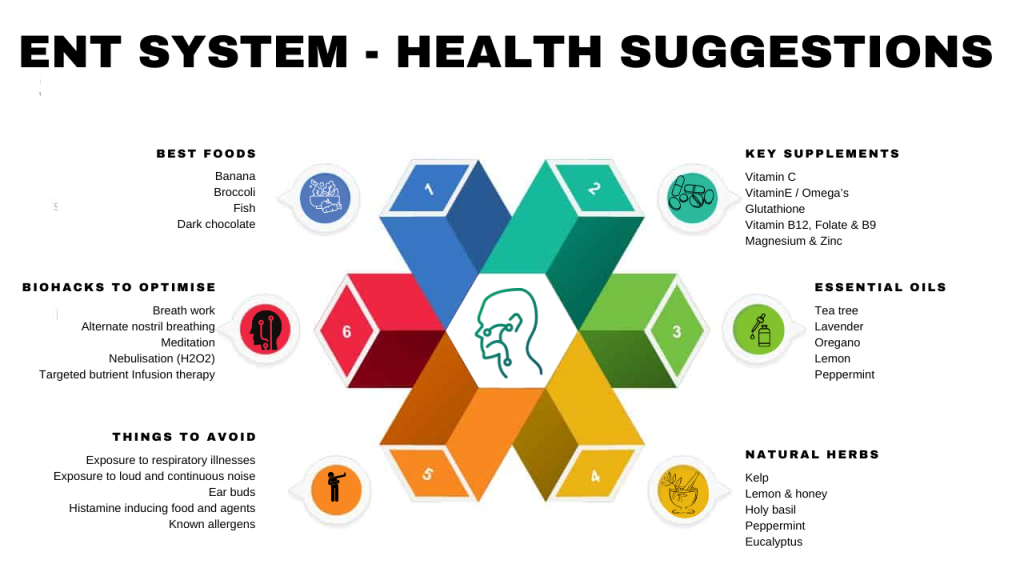With the change in seasons, we have decided to discuss the ear, nose and throat body system. We will discuss how the health of this system can affect your overall quality of health.
Interestingly in South Africa, Almost 20% of general practitioner (GP) visits involve complaints arising from the ears, nose or throat. In the paediatric population, this figure rises to around 50%.
We will cover the disorders, risk factors and best way to naturally improve your ENT health.
Disease prevalence and the facts

In SA, communicable and non-communicable ENT diseases are interlinked owing largely to the high prevalence of HIV and the increasing problem of multi-drug resistant (MDR) TB. Along with this diseases like hearing impairment and head and neck cancers are major public health concerns.
According to the World Health Organization (WHO), hearing impairment is the greatest sensory deficit globally. There are 360 million people worldwide suffering from disabling hearing loss (>40 db).
There are many different ear, nose, and throat (ENT) disorders and an even greater variety of characteristic symptoms. The following list involves the four most common ENT disorders. Not everyone will experience the same set of symptoms or have them as intensely.
Ear Infections
Ear infections are one of the most prevalent ENT disorders. They occur when germs become trapped inside the middle ear.
The eustachian tube, a tiny canal that originates in the ear and drains into the back of the throat, usually keeps unwanted germs out. If this tube is too small or becomes swollen shut by swelling or clogged by fluid and mucus, bacteria, or other microbes can enter the ear and cause an infection.
Signs and symptoms of an ear infection include –
- Pain and pressure
- Fever
- Loss of balance
- Difficulty hearing
- Nausea and vomiting
- Fluid discharge (suggestive of a perforation)
Ear infections are more common in children than adults and the most common type of infection in infants and toddlers.
Strep Throat
Strep is an abbreviation for a family of bacteria called Streptococci. Strep throat occurs when the throat and surrounding structures become infected with this germ. While strep throat is a common infection, many other infections have the same symptoms.
Symptoms are usually abrupt in onset including –
- Sore throat
- Difficulty swallowing
- Enlarged tonsils
- Enlarged lymph nodes
- White patches on the tonsils or back of the throat
- Fever
- Body aches
- Fatigue
Notably absent in strep throat are a runny nose and cough. You may also suspect strep throat if you have been exposed to someone with a strep infection in the last two weeks.
Sinusitis
Sinusitis occurs when a germ multiplies in the hollow recesses of the skull that surrounds your eyes and nose. The infection can become trapped, causing inflammation, pressure, and pain.
Acute sinusitis is often secondary to a common cold, so you are more likely to get sinusitis during the winter months. Chronic sinusitis in which symptoms persist for more than 12 weeks may occur as a result of an untreated allergy or a chronic condition such as bronchial asthma.
Symptoms of sinusitis include –
- Headache
- Cough
- Nasal discharge
- Congestion
- Fever
- Fatigue
- Toothache (mainly of the molars)
Sleep Apnea
Apnea is a medical term meaning to stop breathing. Sleep apnea is a disorder causing one to stop breathing for brief periods of time while sleeping.
Symptoms include –
- Waking up frequently in the middle of the night
- Feeling unrefreshed upon awakening
- Daytime drowsiness
- Mood swings
- Depression
- Waking up with a dry, sore throat
- Morning headaches
In addition to these symptoms, many individuals with sleep apnea have been told by a spouse or family member that they snore, gasp, choke, or even stop breathing momentarily while sleeping. You are more likely to have sleep apnea if you are overweight, have enlarged tonsils, or take sedatives at bedtime.
Obstructive sleep apnea (OSA) occurs in 2% of middle-aged women and 4% of middle-aged men, particularly those who are obese. If left untreated, sleep apnea can cause potentially serious health complications, including hypertension (high blood pressure), coronary artery disease, stroke, and heart failure.
Head, Neck & Hearing Disorders
Up to 100% of HIV-positive patients will present with head and neck manifestations.
Oral candidiasis and rhinosinusitis were traditionally documented as the most common ENT manifestations of HIV.
The global burden of illness from chronic active otitis media involves 65 – 330 million individuals with otorrhoea, 60% of whom suffer from significant hearing impairment.
Perhaps most tragic, 50% of all causes of hearing loss are preventable – causes that can be alleviated by early prevention techniques, including screening programmes and early definitive management strategies.
Risk Factors

Natural ways to improve your ENT Health

In Summary
The majority of people will experience one or more of these disorders in their lifetime. While visiting with your healthcare provider, discussion of your symptoms may help your healthcare provider to come up with a diagnosis of an ENT disorder and can provide you with treatment options.
Other treatment options particularly for allergic type disorders is to boost your immune system.
Book your Balanced Healing Infusion therapy that will boost your immune system.
Reference
Website – https://www.verywellhealth.com/symptoms-of-ent-disorders
Website – http://www.samj.org.za/index.php/samj/article/view/7121/5200

